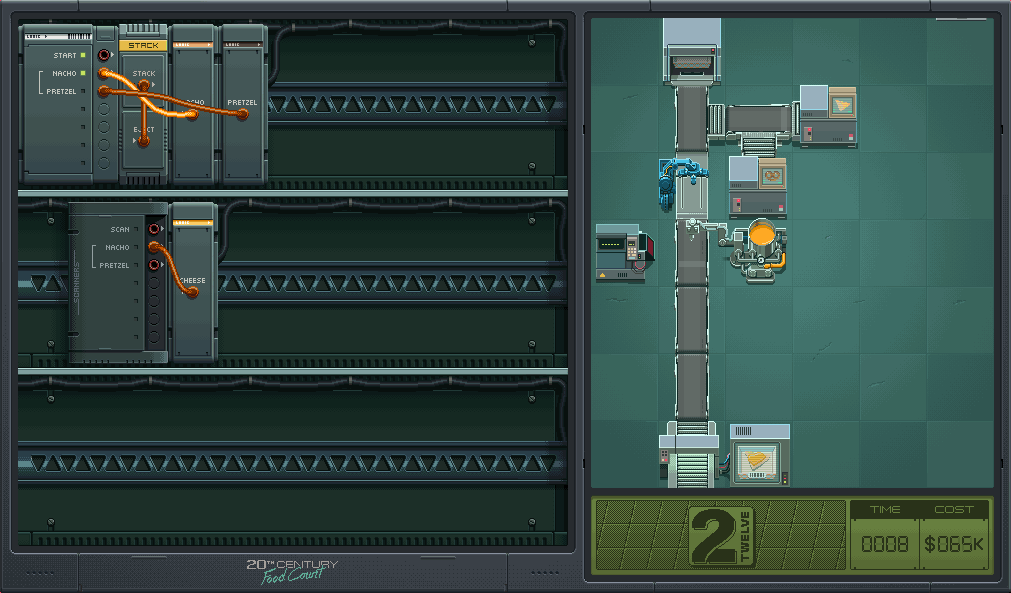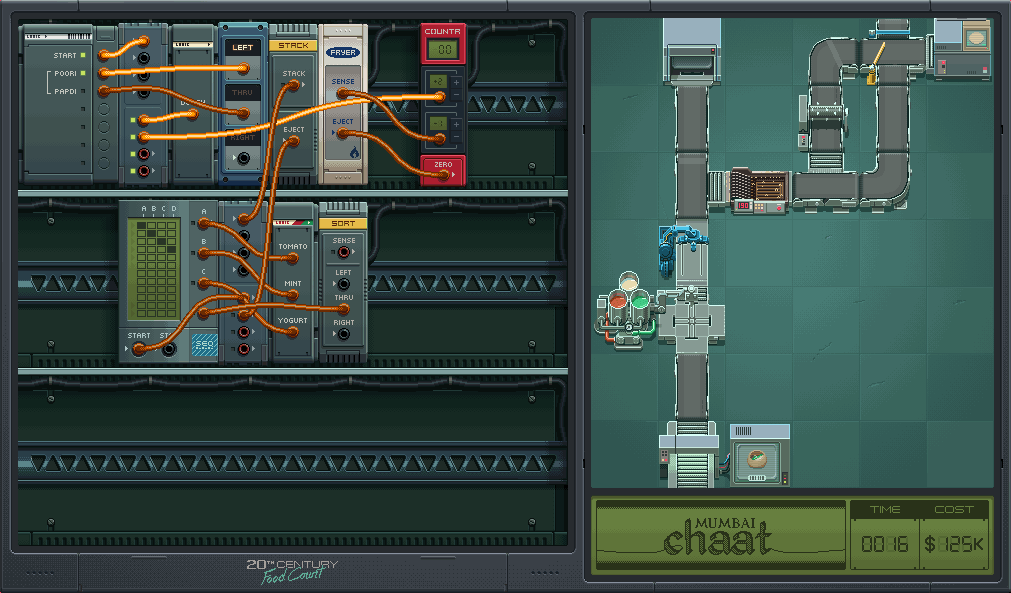The last Zachtronics game is out. There has yet to be any other game studio whose games scratched the engineering and design itch as well as Zachtronics's. I even ordered the deluxe physical edition. I'll miss Zachtronics. Good luck to Zach though. Despite how niche programming games are, they've been a huge positive influence in the game industry.

The game was released 2 days ago and I have been playing it nonstop. I have the Zimaboard/CasaOS review post in the drafts but I haven't gotten around to adding details, so this post comes first. Also, this game is much cooler than the Zimaboard :^)
(Yes, I should be studying, but this is a Zachtronics game!! Playing Zachtronics games is arguably more educational than interview prep. I mean this completely unironically.)
The dev suggested not opening the envelope until the game was released, so for this blog post I opened it up. It's a really cute little iron-on patch for one of the games, 20th Century Food Court. It's by far my favorite game out of the set, so I'm really happy. I'll permanently attach it to something after I complete all the levels.

The game itself is actually a simulation of an imaginary line of Sawayama computers. After the pseudo-BIOS bootup, you see a barebones desktop.

The HandyMate is a skeumorphic PDA resembling the Palm Pilot. Notes are gradually unlocked as you progress through all the games. The Sawayama computers are imaginary, but some of these notes feel so personal that I wonder if it's really Zach's personal experiences told through a fake product instead of a fictional wistful narrative of retro computing.

The built-in Sawayama Solitaire is quite difficult. You can only stack alternating colors of adjacent values, and not all hands are winnable. My sister and I won 10 for the achievement and peaced out. She thought the game was too malding. I'm generally not too interested in card games. Still, this looks harder than the rules make it sound.

The real meat of the game is in Drive 0. It starts off with only the NETronics Connect application. The rest are "minigames." I say this with dubious quotes because that would imply these games are short and sweet. They are not. They are fucking hard as shit and have a ton of content. As of writing, my Steam playtime is 17 hours and I've maybe scratched 10% of the available content. And that 90% is the easy stuff. It only gets harder and harder.

After connecting to Last Call BBS via NETronics Connect, complete with dialup connection noises, you get a listing of warez software to download.


If you choose to download, which mine is grayed out because I already did, in true retro computing fashion, you even get to experience shitty dialup speeds. And a 15 minutes download cooldown. I love it.

I'll only talk about 20th Century Food Court and ChipWizard, since they're the most interesting to me.
20th Century Food Court
This game is about automating the kitchen backend using a variety of machines. It's a mix of combinational logic and finite state machine design. Add in actual wires you have to connect and you have some real cable horror going on.

Let's take a look at the first level, 2 Twelve. Very cute and "beginner friendly." I spent half an hour fumbling around with the controls because I had no idea how to operate any of the devices. The goal is to automate nacho + cheese and pretzel orders.


This is what my final design looks like.

The greatest thing about Zachtronics games is the leaderboards. Every Zachtronics game I've played has had leaderboards for time/cycles and cost/space, along with aggregated statistics from other players. It's a perfect way to illustrate the time/space tradeoff in many designs. In a lot of levels, time-optimizations require sacrificing space and vice versa. Rarely can there be an optimal design for both. But when it happens, oh so satisfying.
The other super neat feature is recording. Spacechem had it, and so does 20th Century Food Court. You get to see your entire design complete all the orders and what the components are doing in real time. Spacechem recorded into MP4, but this game records a tiny GIF. Below is what the automated flow looks like.

The content escalates until, for example, Mumbai Chaat, where you get an entire screen of components. The wiring is also a nightmare. I really dislike not being to label the components. Getting distracted is so easy, and then I forget what the multimixer is supposed to do, and then I have to delete everything and start over. Designing the solutions is really hard without taking notes.



The real fun/mald happens when you start trying to optimize. Seeing the leaderboard percentiles have way better metrics is such a hype way to rise to the challenge. I'm personally extremely proud of my Wine 'o Clock design. I spent way more time than I'd like to admit designing a cheaper optimal solution. And by golly, I did it. I even got a comment on my public uploaded screenshot asking for a hint. Let it be known that I am THE first person to get the 61k that's also time-optimized.

I honestly love 20th Century Food Court. I think I'll make another post sometime dedicated to different solution designs. It's so much fun.
ChipWizard Professional
A full on integrated circuit design program designed as a game. I have absolutely no background in the science behind ICs, the physics is just too hard for me to understand. With that said, I felt much smarter playing the game, even if I still have no idea why the transistors are doing what they do.





That's it, you are now equipped with all the knowledge to design ICs (???)
The basic interface looks exactly what I expect a chip CAD tool to look like. Having multiple revisions is such a nice feature, especially when trying to optimize designs without mucking up a working prototype.

The oscilloscope below cycles when you test the simulation. Everything lights up when activated, it's all quite flashy. If the design is verified to be working, you get a nice leaderboard. I didn't understand how calculation worked until I played some more. Only the area of the capacitors, N, and P-type vias count.

Gonna be honest, I spent way more time than I should have being confused by how to design an OR gate. My main issue was signal interference backfeeding into the inputs. I'm lowkey proud that I resisted the temptation to peek at hints and figured it out myself.


I'm not even doing full on working circuits yet, just baby transistor logic. Assuming the whole file browser will be populated with designs at the end, I am going to suffer a lot. But since AND and NOT gates have been introduced, I can spam NAND gates to victory.

The goal for the rest of this year is to get 100% achievement completion. I want to be that 0% Diligent Designer.
